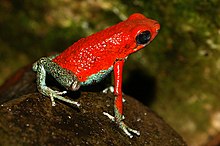
Poison dart frog is the common name of a group of frogs in the family Dendrobatidae which are native to tropical Central and South America. These species are diurnal and often have brightly colored bodies. This bright coloration is correlated with the toxicity of the species, making them aposematic. Some species of the family Dendrobatidae exhibit extremely bright coloration along with high toxicity — a feature derived from their diet of ants, mites and termites— while species which eat a much larger variety of prey have cryptic coloration with minimal to no amount of observed toxicity. Many species of this family are threatened due to human infrastructure encroaching on their habitats.

The strawberry poison frog, strawberry poison-dart frog or blue jeans poison frog is a species of small poison dart frog found in Central America. It is common throughout its range, which extends from eastern central Nicaragua through Costa Rica and northwestern Panamá. The species is often found in humid lowlands and premontane forest, but large populations are also found in disturbed areas such as plantations. The strawberry poison frog is perhaps most famous for its widespread variation in coloration, comprising approximately 15–30 color morphs, most of which are presumed to be true-breeding. O. pumilio, while not the most poisonous of the dendrobatids, is the most toxic member of its genus.

The harlequin poison frog, also known as harlequin poison-dart frog, is a species of poison dart frog endemic to the Chocó region of western Colombia. The frog is normally found on the ground of tropical rain forests, among fallen limbs or leaf litter. Some frogs traditionally classified as Oophaga histrionica were separated as new species in 2018. These are Oophaga anchicayensis, Oophaga andresi and Oophaga solanensis.

Centrolene prosoblepon is a species of frog in the family Centrolenidae, commonly known as the emerald glass frog or Nicaragua giant glass frog. This species can be found in Ecuador, Colombia, Panama, Costa Rica, Nicaragua, and Honduras. Its natural habitats are lowland tropical forests and montane cloud forests. It is a nocturnal species occurring in low vegetation in mature forests only. It is not considered threatened overall by the IUCN although deforestation and pollution are potential threats, as is chytridiomycosis.
Silverstoneia nubicola is a species of frog in the family Dendrobatidae. It is found in western Colombia, Panama, and southwestern Costa Rica.

Allobates talamancae is a species of frog in the family Aromobatidae. It is found in northwestern Ecuador, western Colombia, Panama, Costa Rica, and southern Nicaragua.

Andinobates altobueyensis is a species of frog in the family Dendrobatidae. It is endemic to Alto del Buey mountain in the Serranía del Baudó range, in the Chocó Department of western Colombia. Its common names include Alto de Buey poison frog, golden poison-arrow frog, and golden poison frog.
The polkadot poison frog is a species of frogs in the family Dendrobatidae endemic to Panama, where it is known as rana venenosa in Spanish. Its natural habitats are humid lowland and montane forests. It is threatened by habitat loss and is listed by the IUCN as being "critically endangered".
The yellow-bellied poison frog, yellow-bellied poison-arrow frog, or yellowbelly poison frog is a species of frog in the family Dendrobatidae. It is found in northwestern Colombia and east-central Panama.

Lehmann's poison frog or the red-banded poison frog is a species of frogs in the family Dendrobatidae endemic to a small part of western Colombia. Its natural habitats are submontane tropical rainforests. It is threatened by habitat loss and collection for the pet trade, and the IUCN lists it as being "critically endangered". It was named after Colombian conservation biologist Federico Carlos Lehmann.
The La Brea poison frog is a species of frogs in the family Dendrobatidae endemic to the Cordillera Occidental in the Cauca Department of Colombia, near La Brea.

The splendid poison frog is an extinct species of poison dart frog that was endemic to the eastern end of Cordillera de Talamanca, western Panama. Its natural habitats are humid lowland and montane forests.
Minyobates steyermarki is a species of frog in the family Dendrobatidae endemic to Cerro Yapacana in southern Venezuela. It is also known by the common names of demonic poison frog, demonic poison-arrow frog, or Yapacana's little red frog. It is monotypic in the genus Minyobates.
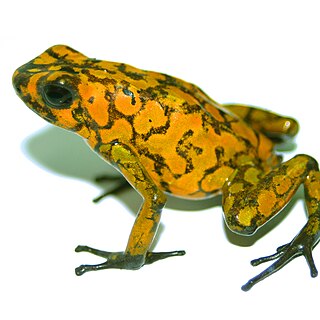
Oophaga sylvatica, sometimes known as its Spanish name diablito, is a species of frog in the family Dendrobatidae found in Southwestern Colombia and Northwestern Ecuador. Its natural habitat is lowland and submontane rainforest; it can, however, survive in moderately degraded areas, at least in the more humid parts of its range. It is a very common frog in Colombia, but has disappeared from much of its Ecuadorian range. It is threatened by habitat loss (deforestation) and agricultural pollution and sometimes seen in the international pet trade.
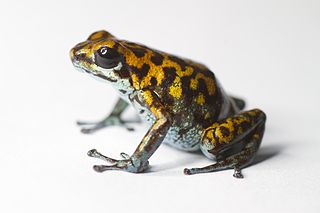
Vicente's poison frog is a species of frog in the family Dendrobatidae that is endemic to the Veraguas and Coclé Provinces of central Panama. It is a little known arboreal frog that inhabits humid tropical lowland and montane forest.
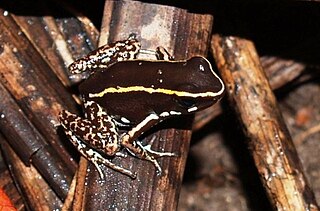
The lovely poison frog or lovely poison-arrow frog is a species of frog in the family Dendrobatidae. It is found on the Caribbean versant of Central America from southeastern Nicaragua through Costa Rica to northwestern Panama, with one record just west of the Panama Canal. Populations from the Pacific versant, formerly included in this species, are now identified as Phyllobates vittatus.
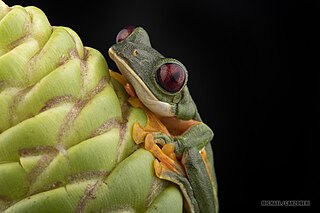
The gliding tree frog is a species of frog in the subfamily Phyllomedusinae. It is found in Colombia, Costa Rica, Ecuador, and Panama. Other common names are the gliding leaf frog, Spurrell's leaf frog, and pink-sided tree frog. The specific name, spurrelli, is in honour of British zoologist Herbert George Flaxman Spurrell.

Dendropsophus phlebodes, the San Carlos treefrog or San Carlos dwarf treefrog, is a species of frog in the family Hylidae. It is found in western Colombia, Costa Rica, Nicaragua and Panama. Its natural habitats are tropical moist lowland forests, but it may also occur in disturbed habitats. It is threatened by habitat loss.
Pristimantis altae, also known as mountain robber frog, is a species of rain frog in the family Strabomantidae with a bright coral-coloured groin. It is found in Costa Rica and Panama.
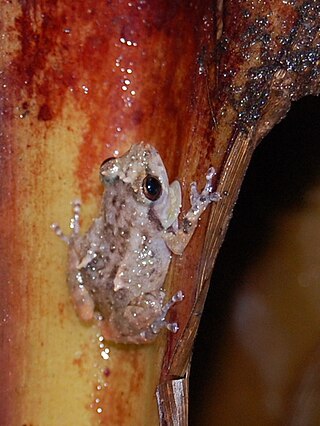
Diasporus diastema is a species of frog in the family Eleutherodactylidae. Common names include common tink frog or dink frog, supposedly because of the loud metallic "tink" sound that the male frog makes during the night. It is found in Central America, from Honduras through Nicaragua and Costa Rica to Panama. Its natural habitats are tropical humid lowland forests and montane forests, but it can use very disturbed habitats. It is found from sea level to 1,620 m (5,310 ft) elevation.
